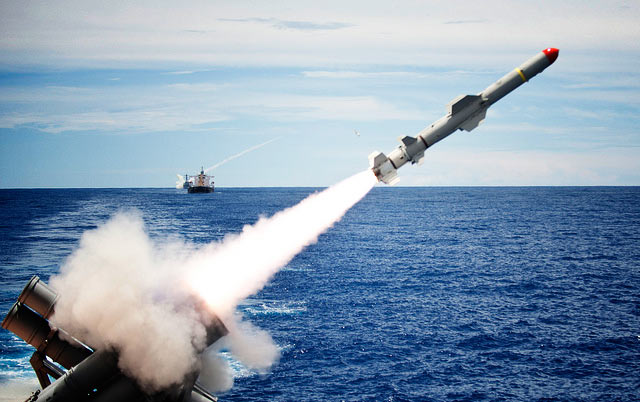
This essay is a joint Truthout/TomDispatch report.
I lived in Anchorage for 10 years and spent much of that time climbing in and on the spine of the state, the Alaska Range. Three times I stood atop the mountain the Athabaskans call Denali, “the great one.” During that decade, I mountaineered for more than half a year on that magnificent state’s highest peaks. It was there that I took in my own insignificance while living amid rock and ice, sleeping atop glaciers that creaked and moaned as they slowly ground their way toward lower elevations.
Alaska contains the largest coastal mountain range in the world and the highest peak in North America. It has more coastline than the entire contiguous 48 states combined and is big enough to hold the state of Texas two and a half times over. It has the largest population of bald eagles in the country. It has 430 kinds of birds along with the brown bear, the largest carnivorous land mammal in the world, and other species ranging from the pygmy shrew that weighs less than a penny to gray whales that come in at 45 tons. Species that are classified as “endangered” in other places are often found in abundance in Alaska.
Now, a dozen years after I left my home state and landed in Baghdad to begin life as a journalist and nine years after definitively abandoning Alaska, I find myself back. I wish it was to climb another mountain, but this time, unfortunately, it’s because I seem increasingly incapable of escaping the long and destructive reach of the US military.
That summer in 2003 when my life in Alaska ended was an unnerving one for me. It followed a winter and spring in which I found myself protesting the coming invasion of Iraq in the streets of Anchorage, then impotently watching the televised spectacle of the Bush administration’s “shock and awe” assault on that country as Baghdad burned and Iraqis were slaughtered. While on Denali that summer I listened to news of the beginnings of what would be an occupation from hell and, in my tent on a glacier at 17 thousand feet, wondered what in the world I could do.
In this way, in a cloud of angst, I traveled to Iraq as an independent news team of one and found myself reporting on atrocities that were evident to anyone not embedded with the US military, which was then laying waste to the country. My early reporting, some of it for TomDispatch, warned of body counts on a trajectory toward one million, rampant torture in the military’s detention facilities, and the toxic legacy it had left in the city of Fallujah thanks to the use of depleted uranium munitions and white phosphorous.
As I learned, the US military is an industrial-scale killing machine and also the single largest consumer of fossil fuels on the planet, which makes it a major source of the greenhouse gas carbon dioxide. As it happens, distant lands like Iraq sitting atop vast reservoirs of oil and natural gas are by no means its only playing fields.
Take the place where I now live, the Olympic Peninsula in Washington state. The US Navy already has plans to conduct electromagnetic warfare training in an area close to where I moved to once again seek solace in the mountains: Olympic National Forest and nearby Olympic National Park. And this June, it’s scheduling massive war games in the Gulf of Alaska, including live bombing runs that will mean the detonation of tens of thousands of pounds of toxic munitions, as well as the use of active sonar in the most pristine, economically valuable, and sustainable salmon fishery in the country (arguably in the world). And all of this is to happen right in the middle of fishing season.
This time, in other words, the bombs will be falling far closer to home. Whether it’s war-torn Iraq or “peaceful” Alaska, Sunnis and Shi’ites or salmon and whales, to me the omnipresent “footprint” of the US military feels inescapable.
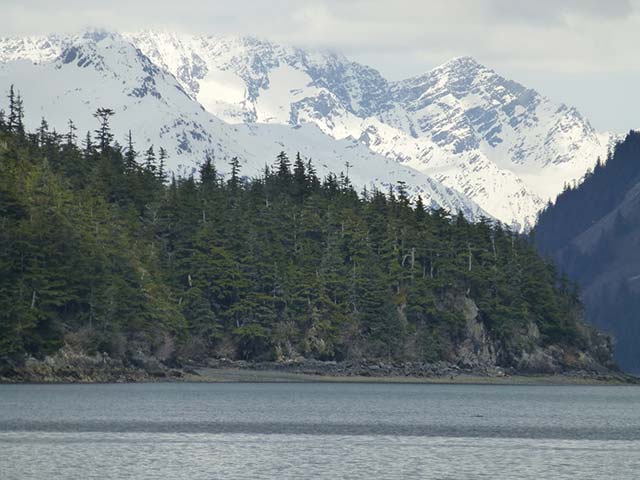 All of Southeast Alaska’s pristine coastline would be impacted by the Navy’s upcoming planned war games in the Gulf of Alaska. (Photo: Dahr Jamail/Truthout)
All of Southeast Alaska’s pristine coastline would be impacted by the Navy’s upcoming planned war games in the Gulf of Alaska. (Photo: Dahr Jamail/Truthout)
The War Comes Home
In 2013, US Navy researchers predicted ice-free summer Arctic waters by 2016 and it looks as if that prediction might come true. Recently, the National Oceanic and Atmospheric Administration (NOAA) reported that there was less ice in the Arctic this winter than in any other winter of the satellite era. Given that the Navy has been making plans for “ice-free” operations in the Arctic since at least 2001, their June “Northern Edge” exercises may well prove to be just the opening salvo in the future northern climate wars, with whales, seals, and salmon being the first in the line of fire.
In April 2001, a Navy symposium entitled “Naval Operations in an Ice-Free Arctic” was mounted to begin to prepare the service for a climate-change-induced future. Fast forward to June 2015. In what the military refers to as Alaska’s “premier” joint training exercise, Alaskan Command aims to conduct “Northern Edge” over 8,429 nautical miles, which include critical habitat for all five wild Alaskan salmon species and 377 other species of marine life. The upcoming war games in the Gulf of Alaska will not be the first such exercises in the region — they have been conducted, on and off, for the last 30 years — but they will be the largest by far. In fact, a 360 percent rise in munitions use is expected, according to Emily Stolarcyk, the program manager for the Eyak Preservation Council (EPC).
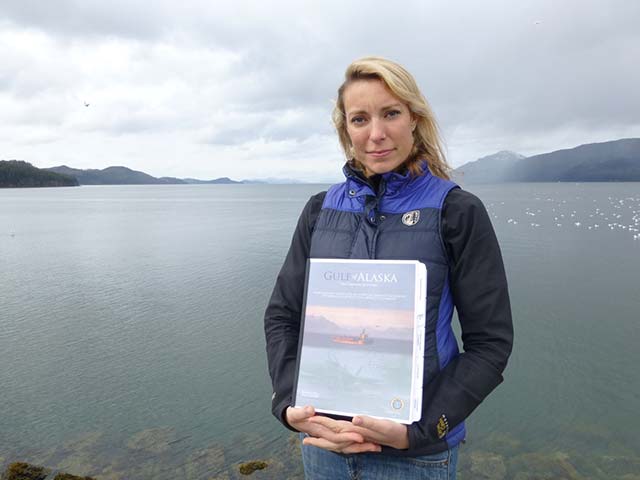 Eyak Preservation Council’s Emily Stolarcyk in Cordova, Alaska, with the Navy’s environmental impact statement for their planned war games in the Gulf of Alaska. (Photo: Dahr Jamail/Truthout)
Eyak Preservation Council’s Emily Stolarcyk in Cordova, Alaska, with the Navy’s environmental impact statement for their planned war games in the Gulf of Alaska. (Photo: Dahr Jamail/Truthout)
The waters in the Gulf of Alaska are some of the most pristine in the world, rivaled only by those in the Antarctic, and among the purest and most nutrient-rich waters anywhere. Northern Edge will take place in an Alaskan “marine protected area,” as well as in a NOAA-designated “fisheries protected area.” These war games will also coincide with the key breeding and migratory periods of the marine life in the region as they make their way toward Prince William Sound, as well as further north into the Arctic.
Species affected will include blue, fin, gray, humpback, minke, sei, sperm, and killer whales, the highly endangered North Pacific right whale (of which there are only approximately 30 left), as well as dolphins and sea lions. No fewer than a dozen native tribes including the Eskimo, Eyak, Athabascan, Tlingit, Sun’aq, and Aleut rely on the area for subsistence living, not to speak of their cultural and spiritual identities.
The Navy is already permitted to use live ordnance including bombs, missiles, and torpedoes, along with active and passive sonar in “realistic” war gaming that is expected to involve the release of as much as 352,000 pounds of “expended materials” every year. (The Navy’s EIS lists numerous things as “expended materials,” including missiles, bombs, torpedoes.) At present, the Navy is well into the process of securing the necessary permits for the next five years and has even mentioned making plans for the next 20. Large numbers of warships and submarines are slated to move into the area and the potential pollution from this has worried Alaskans who live nearby.
“We are concerned about expended materials in addition to the bombs, jet noise, and sonar,” the Eyak Preservation Council’s Emily Stolarcyk tells me as we sit in her office in Cordova, Alaska. EPC is an environmental and social-justice-oriented nonprofit whose primary mission is to protect wild salmon habitat. “Chromium, lead, tungsten, nickel, cadmium, cyanide, ammonium perchlorate, the Navy’s own environmental impact statement says there is a high risk of chemical exposure to fish.”
Tiny Cordova, population 2,300, is home to the largest commercial fishing fleet in the state and consistently ranks among the top 10 busiest US fishing ports. Since September, when Stolarcyk first became aware of the Navy’s plans, she has been working tirelessly, calling local, state and federal officials and alerting virtually every fisherman she runs into about what she calls “the storm” looming on the horizon. “The propellants from the Navy’s missiles and some of their other weapons will release benzene, toluene, xylene, polycyclic aromatic hydrocarbons, and naphthalene into the waters of twenty percent of the training area, according to their own EIS [environmental impact statement],” she explains as we look down on Cordova’s harbor with salmon fishing season rapidly approaching. As it happens, most of the chemicals she mentioned were part of BP’s disastrous 2010 oil spill in the Gulf of Mexico, which I covered for years, so as I listened to her I had an eerie sense of futuristic déjà vu.
 Cordova, Alaska consistently ranks in the top-10 busiest US commercial fishing ports. (Photo: Dahr Jamail/Truthout)
Cordova, Alaska consistently ranks in the top-10 busiest US commercial fishing ports. (Photo: Dahr Jamail/Truthout)
Here’s just one example of the kinds of damage that will occur: the cyanide discharge from a Navy torpedo is in the range of 140-150 parts per billion. The Environmental Protection Agency’s “allowable” limit on cyanide: one part per billion.
The Navy’s EIS estimates that, in the five-year period in which these war games are to be conducted, there will be more than 182,000 “takes” — direct deaths of a marine mammal, or the disruption of essential behaviors like breeding, nursing, or surfacing. On the deaths of fish, it offers no estimates at all. Nevertheless, the Navy will be permitted to use at least 352,000 pounds of expended materials in these games annually. The potential negative effects could be far-reaching, given species migration and the global current system in northern waters.
In the meantime, the Navy is giving Stolarcyk’s efforts the cold shoulder, showing what she calls “total disregard toward the people making their living from these waters.” She adds, “They say this is for national security. They are theoretically defending us, but if they destroy our food source and how we make our living, while polluting our air and water, what’s left to defend?”
Stolarcyk has been labeled an “activist” and “environmentalist,” perhaps because the main organizations she’s managed to sign on to her efforts are indeed environmental groups like the Alaska Marine Conservation Council, and the Alaskans First Coalition.
“Why does wanting to protect wild salmon habitat make me an activist?” she asks. “How has that caused me to be branded as an environmentalist?” Given that the Alaska commercial fishing industry could be decimated if its iconic “wild-caught” salmon turn up with traces of cyanide or any of the myriad chemicals the Navy will be using, Stolarcyk could as easily be seen as fighting for the well-being, if not the survival, of the fishing industry in her state.
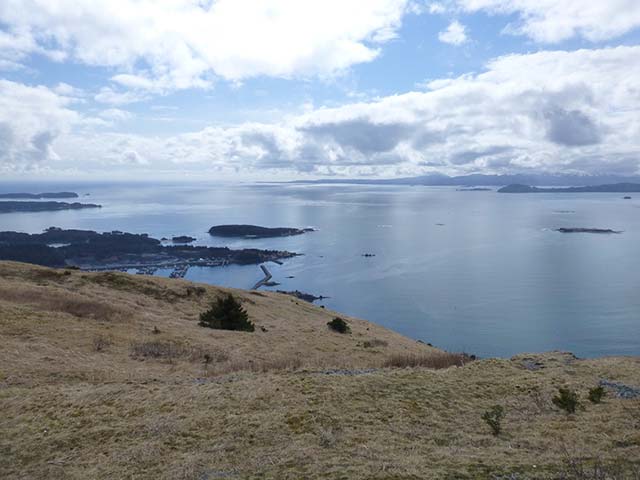 All of the Native Tribes and Villages of Kodiak, Alaska are opposed to the Navy’s planned war games in the Gulf of Alaska. (Photo: Dahr Jamail/Truthout)
All of the Native Tribes and Villages of Kodiak, Alaska are opposed to the Navy’s planned war games in the Gulf of Alaska. (Photo: Dahr Jamail/Truthout)
War Gaming the Community
The clock is ticking in Cordova and others in Stolarcyk’s community are beginning to share her concerns. A few like Alexis Cooper, the executive director of Cordova District Fishermen United (CDFU), a non-profit organization that represents the commercial fishermen in the area, have begun to speak out. “We’re already seeing reduced numbers of halibut without the Navy having expanded their operations in the GOA [Gulf of Alaska],” she says, “and we’re already seeing other decreases in harvestable species.”
CDFU represents more than 800 commercial salmon fishermen, an industry that accounts for an estimated 90 percent of Cordova’s economy. Without salmon, like many other towns along coastal southeastern Alaska, it would effectively cease to exist.
Teal Webber, a lifelong commercial fisherwoman and member of the Native Village of Eyak, gets visibly upset when the Navy’s plans come up. “You wouldn’t bomb a bunch of farmland,” she says, “and the salmon run comes right through this area, so why are they doing this now?” She adds, “When all of the fishing community in Cordova gets the news about how much impact the Navy’s war games could have, you’ll see them oppose it en masse.”
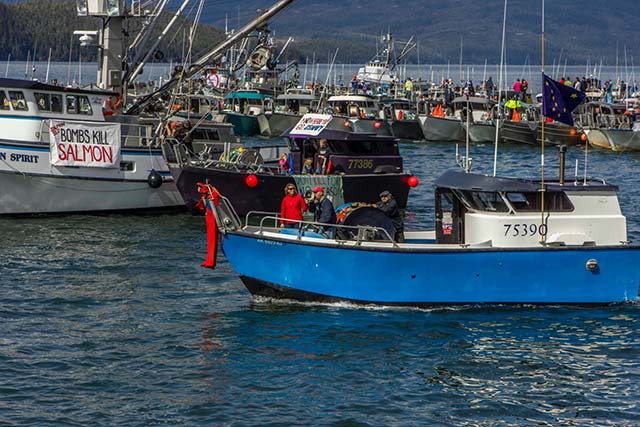 Over 100 fishing vessels participated in a flotilla in Cordova, Alaska on May 16, in opposition to the Navy’s war games. (Photo: Chelsea Tracy Photography)
Over 100 fishing vessels participated in a flotilla in Cordova, Alaska on May 16, in opposition to the Navy’s war games. (Photo: Chelsea Tracy Photography)
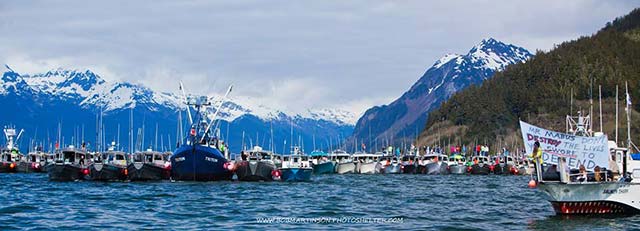 (Photo: Bob Martinson)
(Photo: Bob Martinson)
While I’m in town, Stolarcyk offers a public presentation of the case against Northern Edge in the elementary school auditorium. As she shows a slide from the Navy’s environmental impact statement indicating that the areas affected will take decades to recover, several fishermen quietly shake their heads.
One of them, James Weiss, who also works for Alaska’s Fish and Game Department, pulls me aside and quietly says, “My son is growing up here, eating everything that comes out of the sea. I know fish travel through that area they plan to bomb and pollute, so of course I’m concerned. This is too important of a fishing area to put at risk.”
In the question-and-answer session that follows, Jim Kasch, the town’s mayor, assures Stolarcyk that he’ll ask the city council to become involved. “What’s disturbing is that there is no thought about the fish and marine life,” he tells me later. “It’s a sensitive area and we live off the ocean. This is just scary.” A Marine veteran, Kasch acknowledges the Navy’s need to train, then pauses and adds, “But dropping live ordnance in a sensitive fishery just isn’t a good idea. The entire coast of Alaska lives and breathes from our resources from the ocean.”
That evening, with the sun still high in the spring sky, I walk along the boat docks in the harbor and can’t help but wonder whether this small, scruffy town has a hope in hell of stopping or altering Northern Edge. There have been examples of such unlikely victories in the past. A dozen years ago, the Navy was, for example, finally forced to stop using the Puerto Rican island of Vieques as its own private bombing and test range, but only after having done so since the 1940s. In the wake of those six decades of target practice, the island’s population has the highest cancer and asthma rates in the Caribbean, a phenomenon locals attribute to the Navy’s activities.
Similarly, earlier this year a federal court ruled that Navy war games off the coast of California violated the law. It deemed an estimated 9.6 million “harms” to whales and dolphins via high-intensity sonar and underwater detonations improperly assessed as “negligible” in that service’s EIS.
As a result of Stolarcyk’s work, on May 6th Cordova’s city council passed a resolution formally opposing the upcoming war games. Unfortunately, the largest seafood processor in Cordova (and Alaska), Trident Seafoods, has yet to offer a comment on Northern Edge. Its representatives wouldn’t even return my phone call on the subject. Nor, for instance, has Cordova’s Prince William Sound Science Center, whose president, Katrina Hoffman, wrote me that “as an organization, we have no position statement on the matter at this time.” This, despite their stated aim of supporting “the ability of communities in this region to maintain socioeconomic resilience among healthy, functioning ecosystems.” (Of course, it should be noted that at least some of their funds come from the Navy.)
Government-to-Government Consultation
At Kodiak Island, my next stop, I find a stronger sense of the threat on the horizon in both the fishing and tribal communities and palpable anger about the Navy’s plans. Take J.J. Marsh, the CEO of the Sun’aq Tribe, the largest on the island. “I think it’s horrible,” she says the minute I sit down in her office. “I grew up here. I was raised on subsistence living. I grew up caring about the environment and the animals and fishing in a native household living off the land and seeing my grandpa being a fisherman. So obviously, the need to protect this is clear.”
What, I ask, is her tribe going to do?
She responds instantly. “We are going to file for a government-to-government consultation and so are other Kodiak tribes so that hopefully we can get this stopped.”
The US government has a unique relationship with Alaska’s Native tribes, like all other American Indian tribes. It treats each as if it were an autonomous government. If a tribe requests a “consultation,” Washington must respond and Marsh hopes that such an intervention might help block Northern Edge. “It’s about the generations to come. We have an opportunity as a sovereign tribe to go to battle on this with the feds. If we aren’t going to do it, who is?”
Melissa Borton, the tribal administrator for the Native Village of Afognak, feels similarly. Like Marsh’s tribe, hers was, until recently, remarkably unaware of the Navy’s plans. That’s hardly surprising since that service has essentially made no effort to publicize what it is going to do. “We are absolutely going to be part of this [attempt to stop the Navy],” she tells me. “I’m appalled.”
One reason she’s appalled: she lived through Alaska’s monster Exxon Valdez oil spill of 1989. “We are still feeling its effects,” she says. “Every time they make these environmental decisions they affect us… We are already plagued with cancer and it comes from the military waste already in our ground or that our fish and deer eat and we eat those… I’ve lost family to cancer, as most around here have and at some point in time this has to stop.”
When I meet with Natasha Hayden, an Afognak tribal council member whose husband is a commercial fisherman, she puts the matter simply and bluntly. “This is a frontal attack by the Navy on our cultural identity.”
Gary Knagin, lifelong fisherman and member of the Sun’aq tribe, is busily preparing his boat and crew for the salmon season when we talk. “We aren’t going to be able to eat if they do this. It’s bullshit. It’ll be detrimental to us and it’s obvious why. In June, when we are out there, salmon are jumping [in the waters] where they want to bomb as far as you can see in any direction. That’s the salmon run. So why do they have to do it in June? If our fish are contaminated, the whole state’s economy is hit. The fishing industry here supports everyone and every other business here is reliant upon the fishing industry. So if you take out the fishing, you take out the town.”
The Navy’s Free Ride
I requested comment from the US military’s Alaskan Command office, and Captain Anastasia Wasem responded after I returned home from my trip north. In our email exchange, I asked her why the Navy had chosen the Gulf of Alaska, given that it was a critical habitat for all five of the state’s wild salmon. She replied that the waters where the war games will occur, which the Navy refers to as the Temporary Maritime Activities Area, are “strategically significant” and claimed that a recent “Pacific command study” found that naval training opportunities are declining everywhere in the Pacific “except Alaska,” which she referred to as “a true national asset.”
“The Navy’s training activities,” she added, “are conducted with an extensive set of mitigation measures designed to minimize the potential risk to marine life.”
In its assessment of the Navy’s plans, however, the National Marine Fisheries Service (NMFS), one of the premier federal agencies tasked with protecting national fisheries, disagreed. “Potential stressors to managed species and EFH [essential fish habitat],” its report said, “include vessel movements (disturbance and collisions), aircraft overflights (disturbance), fuel spills, ship discharge, explosive ordnance, sonar training (disturbance), weapons firing/nonexplosive ordnance use (disturbance and strikes), and expended materials (ordnance-related materials, targets, sonobuoys, and marine markers). Navy activities could have direct and indirect impacts on individual species, modify their habitat, or alter water quality.” According to the NMFS, effects on habitats and communities from Northern Edge “may result in damage that could take years to decades from which to recover.”
Captain Wasem assured me that the Navy made its plans in consultation with the NMFS, but she failed to add that those consultations were found to be inadequate by the agency or to acknowledge that it expressed serious concerns about the coming war games. In fact, in 2011 it made four conservation recommendations to avoid, mitigate, or otherwise offset possible adverse effects to essential fish habitat. Although such recommendations were non-binding, the Navy was supposed to consider the public interest in its planning.
One of the recommendations, for instance, was that it develop a plan to report on fish mortality during the exercises. The Navy rejected this, claiming that such reporting would “not provide much, if any, valuable data.” As Stolarcyk told me, “The Navy declined to do three of their four recommendations, and NMFS just rolled over.”
I asked Captain Wasem why the Navy choose to hold the exercise in the middle of salmon fishing season.
“The Northern Edge exercise is scheduled when weather is most conducive for training,” she explained vaguely, pointing out that “the Northern Edge exercise is a big investment for DoD [the Department of Defense] in terms of funding, use of equipment/fuels, strategic transportation, and personnel.”
Arctic Nightmares
The bottom line on all this is simple, if brutal. The Navy is increasingly focused on possible future climate-change conflicts in the melting waters of the north and, in that context, has little or no intention of caretaking the environment when it comes to military exercises. In addition, the federal agencies tasked with overseeing any war-gaming plans have neither the legal ability nor the will to enforce environmental regulations when what’s at stake, at least according to the Pentagon, is “national security.”
Needless to say, when it comes to the safety of locals in the Navy’s expanding area of operation, there is no obvious recourse. Alaskans can’t turn to NMFS or the Environmental Protection Agency or NOAA. If you want to stop the US military from dropping live munitions, or blasting electromagnetic radiation into national forests and marine sanctuaries, or poisoning your environment, you’d better figure out how to file a major lawsuit or, if you belong to a Native tribe, demand a government-to-government consultation and hope it works. And both of those are long shots, at best.
Meanwhile, as the race heats up for reserves of oil and gas in the melting Arctic that shouldn’t be extracted and burned in the first place, so do the Navy’s war games. From southern California to Alaska, if you live in a coastal town or city, odds are that the Navy is coming your way, if it’s not already there.
Nevertheless, Emily Stolarcyk shows no signs of throwing in the towel, despite the way the deck is stacked against her efforts. “It’s supposedly our constitutional right that control of the military is in the hands of the citizens,” she told me in our last session together. At one point, she paused and asked, “Haven’t we learned from our past mistakes around not protecting salmon? Look at California, Oregon, and Washington’s salmon. They’ve been decimated. We have the best and most pristine salmon left on the planet, and the Navy wants to do these exercises. You can’t have both.”
Stolarcyk and I share a bond common among people who have lived in our northernmost state, a place whose wilderness is so vast and beautiful as to make your head spin. Those of us who have experienced its rivers and mountains, have been awed by the northern lights, and are regularly reminded of our own insignificance (even as we gained a new appreciation for how precious life really is) tend to want to protect the place as well as share it with others.
“Everyone has been telling me from the start that I’m fighting a lost cause and I will not win,” Stolarcyk said as our time together wound down. “No other non-profit in Alaska will touch this. But I actually believe we can fight this and we can stop them. I believe in the power of one. If I can convince someone to join me, it spreads from there. It takes a spark to start a fire, and I refuse to believe that nothing can be done.”
Three decades ago, in his book Arctic Dreams, Barry Lopez suggested that, when it came to exploiting the Arctic versus living sustainably in it, the ecosystems of the region were too vulnerable to absorb attempts to “accommodate both sides.” In the years since, whether it’s been the Navy, Big Energy, or the increasingly catastrophic impacts of human-caused climate disruption, only one side has been accommodated and the results have been dismal.
In Iraq in wartime, I saw what the US military was capable of in a distant ravaged land. In June, I’ll see what that military is capable of in what still passes for peacetime and close to home indeed. As I sit at my desk writing this story on Washington’s Olympic Peninsula, the roar of Navy jets periodically rumbles in from across Puget Sound, where a massive naval air station is located. I can’t help but wonder whether, years from now, I’ll still be writing pieces with titles like “Destroying What Remains,” as the Navy continues its war-gaming in an ice-free summer Arctic amid a sea of offshore oil drilling platforms.
Press freedom is under attack
As Trump cracks down on political speech, independent media is increasingly necessary.
Truthout produces reporting you won’t see in the mainstream: journalism from the frontlines of global conflict, interviews with grassroots movement leaders, high-quality legal analysis and more.
Our work is possible thanks to reader support. Help Truthout catalyze change and social justice — make a tax-deductible monthly or one-time donation today.